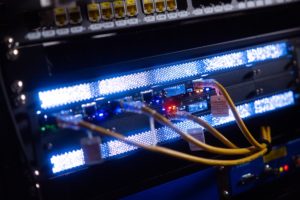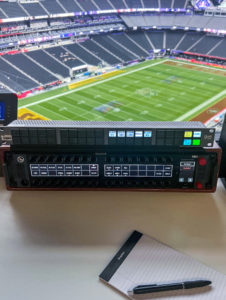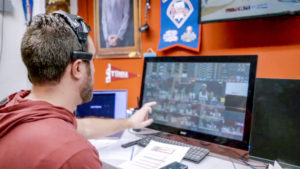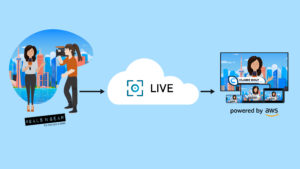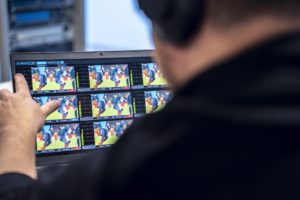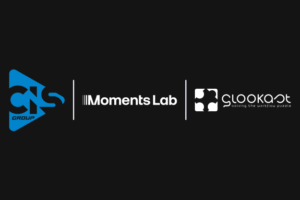This article has been taken from the IABM Journal Issue 108. To see the full Journal click here.

Kathy Bienz
IABM Director, North America
Ahead of NAB Show 2019, we asked members of our Americas Members’ Council to lift the lid on what they see will be the key trends at the show this year. Judging by the spread of their responses, show visitors are going to be very busy keeping up with all the action in our very fast-moving industry. What is clear though is that it is increasingly about technology being harnessed to drive new business models as opposed to the old tech-first approach.
Thomas Tang, President, Apantac
Looking for innovation and emerging technologies
We’re looking forward to another exciting NAB. The pace of change seems more rapid than ever and we see continuous challenges to navigate through these changes. Our customers come to NAB to look for innovative ways to manage and deliver and monetize their content and we enjoy the NAB platform to showcase our solutions to help them do this.
We still see demand for 4K UHD and 12G support, which is why we’ve proactively incorporated HDMI 2.0 output support into our full line of Multiviewers. This ensures an enhanced visual monitoring experience for our customers. This year, we’ll also be keeping a close eye on other emerging technologies and how our customers and the end-users will adopt them. We always try to see beyond the entertainment value and hype of new announcements to see what the real benefits along the content chain are.
John Miller, SVP of Sales and Marketing, BeBop Technology
Learn about the advantages of moving to the cloud
Creating in the cloud is a change from how you’ve used the technology at the office, and a drastic shift from the way we’ve been creating locally for decades. We are no longer limited by geographic constraints, and no longer hindered by creating on a single computer. Just as creative collaboration has evolved from a single meeting room, so has the technology available to enable creation anywhere. But is this technology ready for prime-time post-production?
At NAB Show 2019 I’d recommend you spend time learning about the advantages of moving to the cloud, and the tools and platforms available to do it. You’ll be pleasantly surprised at some of the technologies available today and how working in the cloud can enhance your creative process and make collaboration possible in amazing new ways. Manipulating media in the cloud affords you the freedom to create from wherever you do your best work. Cloud computing allows you to use high powered machines that are often faster than you currently own. Not only are these machines faster, but you have access to more of them! And just as the power and flexibility to create can be dramatically enhanced in the cloud, the same applies to collaboration.
Shawn Maynard, SVP/ GM, Florical Systems
This just might be a ‘wow’ year thanks to AI
NAB is the Media & Entertainment’s version of CES with the Las Vegas convention center packed full of vendors promoting their latest and greatest concepts with the hopes of attracting the attention of the decision makers and buyers. Although long gone are the days of buying products straight from the showroom floor at the special discount prices, NAB is still the place to be to get a pulse on the shifting sands of the industry. Year after year we have seen micro-evolutional progress of products but it has been a very long time since we have seen a macro-evolutional leap product that has caused us to stop and say, ‘wow!’
This just might be that year. Is it 4K, 8K, ST-2110, or cloud playout? No, although those are noteworthy they are still micro evolution level advancements of technology. AI/Machine Learning is the only technology that has the opportunity to radically shift how we do business. Cloud computing is interesting but not compelling from a business standpoint, however, introduce AI technology and we will say ‘wow’ once again with the endless possibilities. Keep an eye on companies introducing amoebas that will grow into a fully functional intelligent future.
Keith Adams, Marketing Communications Manager, GatesAir
Empowering OTA with IP and Software Services
From an OTA infrastructure perspective, it’s clear that broadcasters are planning to integrate even more IP-based and virtualized systems into their existing processes.
IP is no longer optional; it has become a requirement. As with today’s transmitters, IP-based technologies drive today’s control, monitoring, and transport systems with optimal efficiency across time, cost, and a variety of other business-critical factors. Virtualized versions of those systems will further improve their efficiencies, boosting maintenance ease and offering a centralized means of managing multiple aspects of their engineering operations.
As someone who cut the cable cord 10 years ago, I personally rely on OTA and OTT for my TV viewing. I’m hoping that both can embrace more of a cooperative, collaborative relationship built toward mutual success.
To that end GatesAir continues its 97-year legacy of innovation and excellence by pioneering the next-gen tools that OTA TV and radio stations alike need to compete in the mobile, streaming, and increasingly interactive world of today and tomorrow. Between our software-defined Maxiva™ XTE exciter, our fully-embedded Flexiva™ FMXi 4g importer/exporter for HD Radio™, and our new Intraplex® Ascent COTS STL solution, we are actively building and strengthening that digital foundation.
Sean Moran, Chief Operating Officer, Hitachi Kokusai Electric America, Ltd.
Bringing SMPTE 2110 and IP to acquisition
The move to IP-based video transport will continue to be a central theme for our customers and a majority of attendees at NAB. The IP transition is revolutionizing production infrastructures, and the SMPTE ST 2110 suite is critical in ensuring the interoperability that customers need to transition smoothly from SDI to IP.
SMPTE ST 2110 was built on the ST 2022 foundation and uses some of the existing developments but makes several important changes. For bandwidth efficiency, audio, video and data are now separated into different streams. This allows a user to send/receive only what is necessary, instead of the entire SDI package.
Newer network components that are faster and less expensive have become available, enabling ST 2110 to deliver uncompressed video. A future compressed version of ST 2110 is currently moving through the standards committees. Broadcasters and production professionals are eager to understand the technical aspects of SMPTE 2110 in any of these environments, and the new opportunities that come with it.
Hitachi will bring its SMPTE 2110 and IP video transport message to the content acquisition side of the business at NAB. Hitachi HDTV broadcast cameras offer support for SMPTE ST 2110 when paired with IP-enabled models in the CU-HD1300 family of camera control units – thus protecting customers’ investments by not requiring them to purchase new cameras. While development of SMPTE ST 2110 continues, Hitachi lets customers take advantage of the benefits today.
Brick Eksten, CTO, Imagine Communications
Education, standards and embracing new tech to improve ROI
The 2019 NAB Show will mark another milestone for the industry. The three key areas I monitor are awareness and education around new standards, vendor and customer investment in support of those standards, and the level of sophistication in discussions of technology.
In the area of awareness and education, we experience broad acceptance and a greater degree of knowledge around SMPTE ST 2110, virtualization, and cloud. Requirements are starting to appear which provide focus for the vendors, and requests for features are becoming much more specific in their nature.
The level of investment in the industry has improved, and we are seeing those results in the interop sessions where quality, reliability, and interoperability have improved dramatically.
What excites me the most, however, is the level of sophistication in the discussions with our customer partners around advanced topics such as microservices, ML/AI, and streaming data. Topics such as cloud-native designs, dynamic infrastructure, and data governance between microservices are where the industry is becoming much more in tune with how these technologies can come together to improve ROI – and that, of course, is the whole point of the transition to IP, COTS, and cloud-native software.
Dan Montgomery – President of Imagine Products, Inc®
Moving to the cloud across the storytelling chain
At NAB Show 2019 there will be plenty to pique everyone’s attention, though perhaps not as much hardware as software solutions and services. I don’t expect a significant ‘game-changer’, just more of the push towards better handling of digital assets and higher quality imagery.
Last year a search of NAB exhibits mentioning the word ‘cloud’ was about 120. This year it’s over 425. That hints at more fluid digital workflows embracing cloud tools throughout the storytelling chain from beginning to end, rather than simply storage and VOD play-out.
Since one can learn about digital products any time of the year from the web, NAB Show is becoming more of a networking event than ever. Most exhibitors will tell you it’s less about attracting the casual floorwalker and more about acquaintances, friends and attendees who pre-plan their steps and have a focused purpose. That’s good news as visitors are more ‘qualified’ (but it also begs the question about the need for lavish expenditure on booths.)
PS: At some point rebranding maybe in order as ‘National’ isn’t a particularly good fit anymore and neither is ‘Broadcasters’. It’s a global event for anyone handling media.
Ian Sharpe, CEO, Promethean TV
It’s about interaction
NAB has always been about getting ‘up close and personal’ – meeting old colleagues, getting quality face time with new prospective partners, signing up new customers.
Increasingly, the broadcast world is all about the same thing. The audience want to get up close and personal with our content.
It’s not just television (which literally means vision at a distance). It’s about interaction. It’s about a lean-in experience, with direct engagement with touch screen devices. It’s personalized transmissions and tailored advertising that is driven by data. It’s about bite-sized messaging that doesn’t disrupt our viewing. Our audiences crave something that demonstrates context and relevance, that offers them a meaningful choice and it is up to our technologies to deliver it to this exciting new world of cord cutters, binge watchers, content connoisseurs, and esports streamers.
At Promethean, we’re looking forward to the seeing all the innovation and insight that is going into the evolution of how we all watch.
Ted Korte, CTO, Qligent
Business models catching up with technology
We have entered the era of ‘infinite media’ and the battle over Content or Data being King rages on. Not an either/or, it’s both! Advancements in 360, 8K/4K/HDR, Immersive Audio, and AR/VR will be on display from a creation perspective and advancements in Low-Latency OTT, ATSC 3.0, and 5G will dominate from a delivery perspective.
What we are keeping an eye on is how the mega trends are moving and shaping the industry, specifically, Cloud/Virtualization, IoT/Big Data, and AI/ML. These technologies, along with a few others, are essentially pushing for ‘Speed and Efficiency’ via a data-driven strategy and applies throughout the entire supply chain to deliver great content with great quality and a great experience. Savvy visitors will be seeking vendors, such as Qligent, who can support this growing ecosystem. From the list of pavilions and educational forums, many are rethinking old models of how best to produce, deliver and reconcile. Everything is being investigated from advertising, long-form vs. short-form, live vs. on-demand, podcasting, eSports, streaming and In-Vehicle experiences. We’re seeing that business models are finally catching up with technology.
Joe Commare, Marketing Manager, Riedel
IP – learn in audio first and apply the lessons to video
Besides the flurry of M&E activity that we typically see this time of year, the IP transition is gaining speed as many manufacturers and end users have gone from fear and apprehension to understanding and plan formation. The SMPTE ST 2110 suite of standards is firmly established and now we’re working on the last important bits: automated connection management and security.
There will be plenty of new product announcements based on IP workflows and the big decision for end-users will be whether to gradually transition over to IP or just rip off the band-aid and do it all at once. Now that there are some great success stories in the marketplace, clients have much more information to base their decisions on.
At Riedel, we’ve had a fully IP-ready intercom system for several years and, at this point, Artist is the only intercom that’s fully 2110-30 compliant. We believe that audio and comms are a great place to begin an IP transition so that the lessons learned can be later applied to video. Our MediorNet MicroN, equipped with the IP App, can create a bridge from MediorNet networks to IP networks, allowing broadcasters to make the transition at their own pace.



